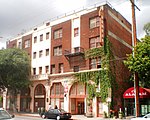Prince Hall Masonic Temple (Los Angeles, California)

The Prince Hall Masonic Temple in South Los Angeles area of Los Angeles, California is a historic club building associated with Prince Hall Freemasonry. It was listed on the National Register of Historic Places in 2009. The structure, built in 1926, is a two-story masonry building which has been described as "very simple in design and almost appears to be commercial in use." The building was established as the Los Angeles branch of Prince Hall Freemasonry, a tradition of separate, predominantly African-American, Freemasonry in North America. The building was deemed to satisfy the registration requirement for club buildings set forth in a multiple property submission study, the African Americans in Los Angeles MPS. The building was deemed significant as one of two remaining Los Angeles club buildings founded by and for African Americans.Other sites listed pursuant to the same African Americans in Los Angeles MPS include the Angelus Funeral Home, Lincoln Theater, Second Baptist Church, 28th Street YMCA, 52nd Place Historic District, 27th Street Historic District, and two historic all-black segregated fire stations (Fire Station No. 14 and Fire Station No. 30).
Excerpt from the Wikipedia article Prince Hall Masonic Temple (Los Angeles, California) (License: CC BY-SA 3.0, Authors, Images).Prince Hall Masonic Temple (Los Angeles, California)
East 50th Street, Los Angeles South Park
Geographical coordinates (GPS) Address Nearby Places Show on map
Geographical coordinates (GPS)
| Latitude | Longitude |
|---|---|
| N 33.997369444444 ° | E -118.25722222222 ° |
Address
East 50th Street 1058
90011 Los Angeles, South Park
California, United States
Open on Google Maps







